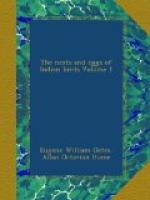There are just as big eggs and just as small ones from Simla and Kotegurh, from Cashmere, from Etawah, Bareilly, Futtehgurh, from Kotagherry, and Conoor; all that one can possibly say is that perhaps the Plains birds do on the average lay a shade larger eggs than the Himalayan or Nilghiri ones.
Taking the eggs as a whole, I think that in size and shape they are about intermediate between the eggs of the European Carrion-Crow and Rook. But they vary, as I said, astonishingly in size, from 1.5 to 1.95 in length, and in breadth from 1.12 to 1.22, and I have one perfectly spherical egg, a deformity of course, which measures 1.25 by 1.2.
The average of thirty Himalayan eggs is 1.73 by 1.18, of twenty Plains eggs 1.74 by 1.2, and of fifteen Nilghiri eggs 1.7 by 1.18. I would venture to predict that with fifty of each, there would not be a hundredth of an inch between their averages.
7. Corvus splendens, Vieill. The Indian House-Crow.
Corvus splendens, Vieill. Jerd. B. Ind.
ii, p. 298.
Corvus impudicus, Hodgs., Hume, Rough Draft N.
& E. no. 663.
Throughout India and Upper Burma the Common Crow resides and breeds, not ascending the hills either in Southern or Northern India to any great elevation, but breeding up to 4000 feet in the Himalayas.
The breeding-season par excellence is June and July, but occasional nests will be found earlier even in Upper India, and in Southern and Eastern India a great number lay in May. The nests are commonly placed in trees without much regard to size or kind, though densely foliaged ones are preferred, and I have just as often found several in the same tree as single ones. At times they will build in nooks of ruins or large deserted buildings, where these are in well inhabited localities, but out of many thousands I have only seen three or four nests in such abnormal positions.
The nest is placed in some fork, and is usually a ragged stick platform, with a central depression lined with grass-roots; but they are not particular as to material; I have found wool, rags, grass, and all kinds of vegetable fibre, and Mr. Blyth mentions that he has “seen several nests composed more or less, and two almost exclusively, of the wires taken from soda-water bottles, which had been purloined from the heaps of these wires commonly set aside by the native servants until they amount to a saleable quantity.” Four is the normal number of eggs laid, but I often have found five, and on two occasions six. It is in this bird’s nest that the Koel chiefly lays.




